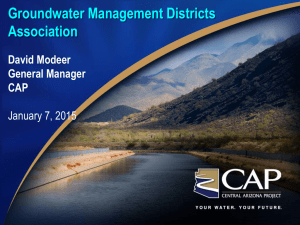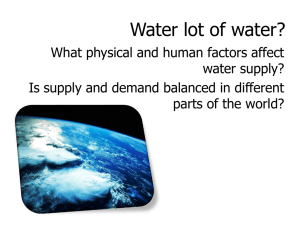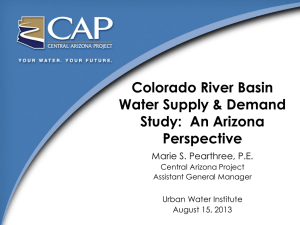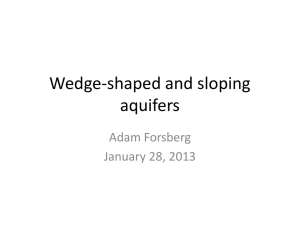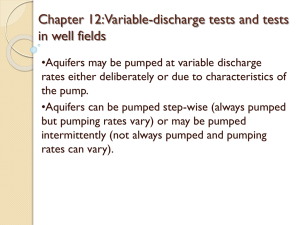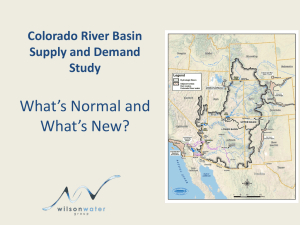Feasibility of Aquifer Storage and Recovery in the Upper Colorado
advertisement
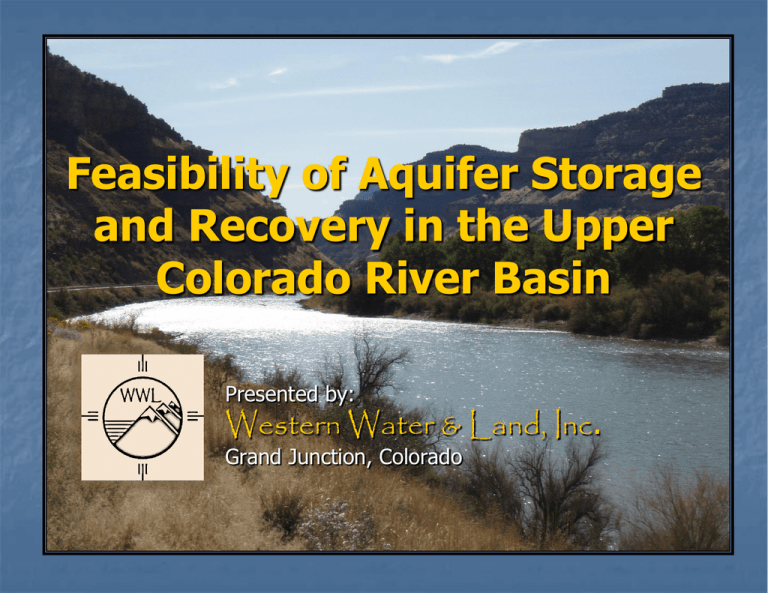
Feasibility of Aquifer Storage and Recovery in the Upper Colorado River Basin Presented by: Western Water & Land, Inc. Grand Junction, Colorado Colorado’s Water Future Current projections indicate Colorado population growth will double by 2050 Existing water supply systems will not be adequate – especially on the front range New storage systems will be needed as part of future water management Continued collaboration will be required among agricultural, municipal, industrial, and recreational water users to sponsor new alternative water supply and storage projects (HB 1177) Western Water & Land, Inc. Aquifer Storage and Recovery (ASR) ASR is a viable storage and water supply alternative The active or passive storage and recovery of artificially recharged source water in aquifers Western Water & Land, Inc. Source: Topper, R. et. al. (2004) Why ASR? Aquifer management and sustainability Supply storage for future and emergency demand Augmentation and legal obligations Western Water & Land, Inc. Advantages of ASR Reduced environmental impact Reduced permitting, cost, and time for storage construction Minimal evaporation losses Improved public safety and source protection Potential for greater public acceptance Western Water & Land, Inc. Disadvantages of ASR Requires initial characterization & baseline program Reduced storage control Extraction limitations (regulatory) Long-term pumping; maintenance and monitoring Chemistry/treatment issues Western Water & Land, Inc. ASR in Colorado In 2003 Director of CDNR called for a statewide assessment of artificial recharge in response to the worse drought year on record in 2002 Resulting study was conducted by CGS and ranked top 16 unconsolidated (alluvial) and top 29 consolidated (bedrock) aquifers throughout the state (generally > 100,000 ac ft) Three alluvial aquifers (1 in the Grand Valley) in the Upper Colorado River Basin (UCRB) ranked in the top 16 alluvial aquifers Eight bedrock aquifers listed in UCRB, (3 in the Piceance Creek Basin: Mesaverde, Uinta, & Wasatch - Ft. Union Fms) Nineteen active artificial recharge projects in the state in 2004; three in the UCRB Western Water & Land, Inc. Active Artificial Recharge in Colorado (2004) Source: Topper, R. et. al. (2004) Western Water & Land, Inc. Key Alluvial Aquifers in Colorado Source: Topper, R. et. al. (2004) Western Water & Land, Inc. Key Bedrock Aquifers in Colorado Source: Topper, R. et. al. (2004) Western Water & Land, Inc. Top Listed Bedrock Aquifers in the Upper Colorado River Basin Troublesome Formation (Middle Park) Weber-Maroon-Minturn Formations (Eagle Basin and vicinity) Uinta Formation – Piceance Creek Basin Wasatch and Fort Union Formations – Piceance Creek Basin Mesaverde Formation (Group) – Piceance Creek Basin Wingate, Morrison, Summerville, Entrada, Dakota, Burro Canyon Formations – Gunnison Basin & SW CO Western Water & Land, Inc. Feasibility Assessment Physical Elements Source water supply Infrastructure Aquifer properties Water chemistry Scale Administrative Elements Cost Water administration Water rights Western Water & Land, Inc. Feasibility Assessment Physical Elements Source Water Supply Capacity Proximity of surface water source to aquifer Infrastructure Conveyance systems: source water, aquifer, and users Wells, pipelines, treatment facilities, power source, distribution systems Aquifer Properties Hydraulic properties (areal extent, thickness, piezometric surface, storage coefficient, hydraulic conductivity) Storage capacity (e.g. >100,000 ac ft) Recharge and discharge pathways (tributary vs. non-tributary) Western Water & Land, Inc. Feasibility Assessment Physical Elements Water Chemistry Chemical compatibility of source water & natural groundwater Is water treatment necessary? Scale Local irrigation districts, industrial, major municipalities Administrative Elements Cost Characterization Infrastructure (pump stations, wells, electrical) Operation and maintenance Legal Fees Western Water & Land, Inc. Feasibility Assessment Administrative Elements Water Administration Can ASR in the UCRB be managed under existing regulations? Will new regulations be basin, aquifer, or project specific? Tributary vs. non-tributary Volume injected vs. volume extracted Water quality issues EPA UIC permit considerations CDPHE (not if exercising a water right) Water Rights Decreed uses, restrictions or limitations, potential impacts to other users Divert under existing rights, new rights or during periods of free river conditions Western Water & Land, Inc. Summary The Upper Colorado River Basin has the source water and promising aquifers for ASR. ASR has potential as a long-term storage alternative. ASR feasibility study followed by a demonstration project is needed now to prepare for future demands. Western Water & Land, Inc. THE END “population is pollution spelled inside out” – David Brower Western Water & Land, Inc.
